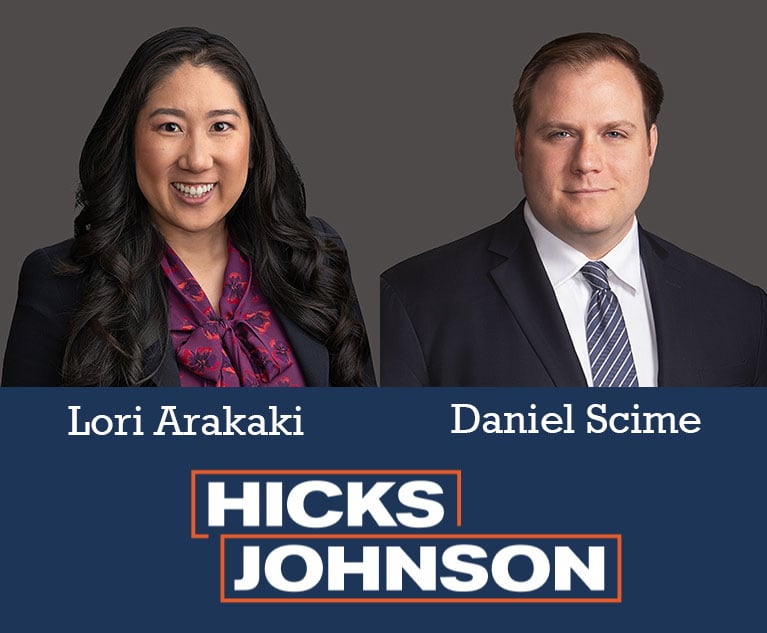12. How to Plan for the Year Ahead
This is the season for business plans, budgets and compensation discussions. Goal setting, managing expectations, identifying resources, and planning methods of work-delivery -- this is essentially what law firm leaders are contemplating at the beginning of the year.
January 14, 2022 at 02:17 PM
4 minute read
The original version of this story was published on Lean Adviser
It's that time again, as we close the book on the year gone and plan the year ahead. On the client side of the market, many GCs are still facing all the familiar challenges, only with less budget and more to achieve. But for many law firms, the mood is altogether brighter. This is the season for business plans, budgets and compensation discussions, and for most, the past year went much better than expected. Demand for M&A, real estate and litigation were up. For many firms, revenues were up, travel costs and other overheads were down, and profit targets were met or even exceeded. For these firms, the sense may be that they have adapted to the pandemic and all is well.
But did law firms really get through the year unscathed, or is this just what they tell themselves based on surface data? This is the time when law firm leaders plan how to go again, and do even better. Planning is the first foundation of the Lean Adviser program, and the parallels are clear. In the context of a client assignment, Lean Adviser has modules on goal setting, managing expectations, identifying resources, and planning methods of work-delivery. This is essentially what law firm leaders are contemplating at the beginning of the year. Those who look "up and out" will see that their clients are still unhappy, and still facing huge challenges. Those who look "down and in" will see an operating model which has become vulnerable to the talent war. As we discuss in Lean Adviser, if you fail to prepare, you prepare to fail.
Here is our laundry list of three areas to consider:
- Goal Setting: In any project in manufacturing, the first question is always "what does good look like?" This is a great question for law firms, and it has two limbs:
- What does client satisfaction look like? To law firms it looks like repeat business, but really that's just the outcome, not how to create it. The deeper question is how do clients actually want outside counsel to operate? This unanswered question is the reason Lean Adviser was created.
- What does associate satisfaction look like? This question has become top of mind for law firm leaders. Just as repeat business is only the outcome of client satisfaction, so good retention is the outcome of associate satisfaction. But if associate satisfaction is a real goal, which it should be, then this poses much deeper questions about inclusive leadership — and of course culture.
- Planning Resources: This is easy to define and hard to solve. We know that firms only have one resource — talent. The challenge is planning how to fill talent in the right areas, at the right levels, and then retain these talented lawyers. A challenge that has become more difficult with the ongoing war for talent.
- Planning Methods: This is the piece which is easiest to miss, but actually goes a long way to answer the previous questions. One of our key tenets is that methods matter. They matter to clients, and they matter to associates. So considered planning is vital. Again, this has two limbs:
- Working methods affect client satisfaction. Expertise is a given, and so method of delivery is the thing they care about most, and the biggest differentiator.
- Working methods affect resources, meaning acquiring and retaining talent. Right now, law firm leaders are trying to plan for the return to office and for ongoing remote operations. These practical things affect associate satisfaction, but don't forget the key behaviors and soft skills which we identified in the previous lesson.
NOT FOR REPRINT
© 2025 ALM Global, LLC, All Rights Reserved. Request academic re-use from www.copyright.com. All other uses, submit a request to [email protected]. For more information visit Asset & Logo Licensing.
You Might Like
View All
Longtime AOC Director Glenn Grant to Step Down, Assignment Judge to Take Over
4 minute read
Hours After Trump Takes Office, Democratic AGs Target Birthright Citizenship Order
4 minute read
Hicks Johnson Promotes Lori Arakaki and Daniel Scime to Firm Partnership
2 minute read
IAG Forensics & Valuation is excited to announce promotions at our firm effective 1/1/2025.
1 minute readTrending Stories
- 1US Judge Dismisses Lawsuit Brought Under NYC Gender Violence Law, Ruling Claims Barred Under State Measure
- 24th Circuit Upholds Virginia Law Restricting Online Court Records Access
- 3Lawsuit Against Major Food Brands Could Be Sign of Emerging Litigation Over Processed Foods
- 4Fellows LaBriola LLP is Pleased to Announce that Alisha Goel Has Become Associated with The Firm
- 5Law Firms Turn to 'Golden Handcuffs' to Rein In Partner Movement
Who Got The Work
J. Brugh Lower of Gibbons has entered an appearance for industrial equipment supplier Devco Corporation in a pending trademark infringement lawsuit. The suit, accusing the defendant of selling knock-off Graco products, was filed Dec. 18 in New Jersey District Court by Rivkin Radler on behalf of Graco Inc. and Graco Minnesota. The case, assigned to U.S. District Judge Zahid N. Quraishi, is 3:24-cv-11294, Graco Inc. et al v. Devco Corporation.
Who Got The Work
Rebecca Maller-Stein and Kent A. Yalowitz of Arnold & Porter Kaye Scholer have entered their appearances for Hanaco Venture Capital and its executives, Lior Prosor and David Frankel, in a pending securities lawsuit. The action, filed on Dec. 24 in New York Southern District Court by Zell, Aron & Co. on behalf of Goldeneye Advisors, accuses the defendants of negligently and fraudulently managing the plaintiff's $1 million investment. The case, assigned to U.S. District Judge Vernon S. Broderick, is 1:24-cv-09918, Goldeneye Advisors, LLC v. Hanaco Venture Capital, Ltd. et al.
Who Got The Work
Attorneys from A&O Shearman has stepped in as defense counsel for Toronto-Dominion Bank and other defendants in a pending securities class action. The suit, filed Dec. 11 in New York Southern District Court by Bleichmar Fonti & Auld, accuses the defendants of concealing the bank's 'pervasive' deficiencies in regards to its compliance with the Bank Secrecy Act and the quality of its anti-money laundering controls. The case, assigned to U.S. District Judge Arun Subramanian, is 1:24-cv-09445, Gonzalez v. The Toronto-Dominion Bank et al.
Who Got The Work
Crown Castle International, a Pennsylvania company providing shared communications infrastructure, has turned to Luke D. Wolf of Gordon Rees Scully Mansukhani to fend off a pending breach-of-contract lawsuit. The court action, filed Nov. 25 in Michigan Eastern District Court by Hooper Hathaway PC on behalf of The Town Residences LLC, accuses Crown Castle of failing to transfer approximately $30,000 in utility payments from T-Mobile in breach of a roof-top lease and assignment agreement. The case, assigned to U.S. District Judge Susan K. Declercq, is 2:24-cv-13131, The Town Residences LLC v. T-Mobile US, Inc. et al.
Who Got The Work
Wilfred P. Coronato and Daniel M. Schwartz of McCarter & English have stepped in as defense counsel to Electrolux Home Products Inc. in a pending product liability lawsuit. The court action, filed Nov. 26 in New York Eastern District Court by Poulos Lopiccolo PC and Nagel Rice LLP on behalf of David Stern, alleges that the defendant's refrigerators’ drawers and shelving repeatedly break and fall apart within months after purchase. The case, assigned to U.S. District Judge Joan M. Azrack, is 2:24-cv-08204, Stern v. Electrolux Home Products, Inc.
Featured Firms
Law Offices of Gary Martin Hays & Associates, P.C.
(470) 294-1674
Law Offices of Mark E. Salomone
(857) 444-6468
Smith & Hassler
(713) 739-1250








